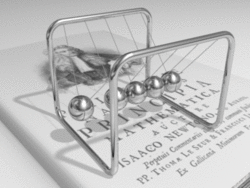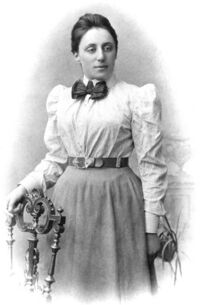Physics:Conservation of momentum
| Continuum mechanics |
|---|
In physics and chemistry, the law of conservation of momentum (or more precisely, the law of conservation of linear momentum) states that the total momentum of an isolated system remains constant. Momentum is therefore said to be conserved over time;[1] that is, momentum is neither created nor destroyed, only transformed or transferred from one form to another.
Conservation of momentum can be rigorously proven by Noether's theorem.
For systems that do not have space translation symmetry, it may not be possible to define conservation of momentum. Examples of these types of systems include curved spacetimes in general relativity[2] or time crystals in condensed matter physics.[3][4][5][6]
The law of conservation of momentum (quantitas motus) was first formulated by René Descartes[7][8].
Conservation of momentum in Newtonian mechanics

In a closed system (one that does not exchange any matter with its surroundings and is not acted on by external forces) the total momentum is constant. This fact, known as the law of conservation of momentum, is implied by Newton's laws of motion.[1][9] Suppose, for example, that two particles interact. Because of the Newton's third law, the forces between them are equal and opposite. If the particles are numbered 1 and 2, the second law states that F1 = dp1/dt and F2 = dp2/dt. Therefore,
with the negative sign indicating that the forces oppose. Equivalently,
If the velocities of the particles are u1 and u2 before the interaction, and afterwards they are v1 and v2, then
This law holds no matter how complicated the force is between particles. Similarly, if there are several particles, the momentum exchanged between each pair of particles adds up to zero, so the total change in momentum is zero. This conservation law applies to all interactions, including collisions and separations caused by explosive forces.[1] It can also be generalized to situations where Newton's laws do not hold, for example in the theory of relativity and in electrodynamics.[10][11]
Conservation of momentum in quantum mechanics
The law of conservation of momentum also holds in quantum mechanics. In those phenomena when the particle properties of particles are manifested, their momentum, as in classical mechanics, is equal to , and when the wave properties of particles are manifested, their momentum is , where is the wavelength. In quantum mechanics, the law of conservation of momentum is a consequence of symmetry with respect to shifts in space.
Noether's theorem

The conservation of momentum is a common feature in many physical theories. From a mathematical point of view it is understood as a consequence of Noether's theorem, developed by Emmy Noether in 1915 and first published in 1918. The theorem states every continuous symmetry of a physical theory has an associated conserved quantity; if the theory's symmetry is space invariance then the conserved quantity is called "momentum". The momentum conservation law is a consequence of the shift symmetry of space; momentum conservation is implied by the empirical fact that the laws of physics do not change in different space points. Philosophically this can be stated as "nothing depends on space per se". In other words, if the physical system is invariant under the continuous symmetry of space translation then its momentum (which is canonical conjugate quantity to coordinate) is conserved. Conversely, systems which are not invariant under shifts in space (an example, systems with space dependent potential energy) do not exhibit conservation of momentum – unless we consider them to exchange energy with another, external system so that the theory of the enlarged system becomes time invariant again. Conservation of momentum for finite systems is valid in such physical theories as special relativity and quantum theory (including QED) in the flat space-time.
References
- ↑ 1.0 1.1 1.2 Feynman Vol. 1, Chapter 10
- ↑ Witten, Edward (1981). "A new proof of the positive energy theorem". Communications in Mathematical Physics 80 (3): 381–402. doi:10.1007/BF01208277. ISSN 0010-3616. Bibcode: 1981CMaPh..80..381W. https://www.sns.ias.edu/ckfinder/userfiles/files/%5B32%5DCMP_80_1981.pdf.
- ↑ Grossman, Lisa (18 January 2012). "Death-defying time crystal could outlast the universe". New Scientist. Archived from the original on 2017-02-02. https://archive.is/20170202104619/https://www.newscientist.com/article/mg21328484-000-death-defying-time-crystal-could-outlast-the-universe/.
- ↑ Cowen, Ron (27 February 2012). ""Time Crystals" Could Be a Legitimate Form of Perpetual Motion". Scientific American. Archived from the original on 2017-02-02. https://archive.is/20170202101455/https://www.scientificamerican.com/article/time-crystals-could-be-legitimate-form-perpetual-motion/.
- ↑ Powell, Devin (2013). "Can matter cycle through shapes eternally?". Nature. doi:10.1038/nature.2013.13657. ISSN 1476-4687. Archived from the original on 2017-02-03. https://archive.is/20170203080014/http://www.nature.com/news/can-matter-cycle-through-shapes-eternally-1.13657.
- ↑ Gibney, Elizabeth (2017). "The quest to crystallize time". Nature 543 (7644): 164–166. doi:10.1038/543164a. ISSN 0028-0836. PMID 28277535. Bibcode: 2017Natur.543..164G. Archived from the original on 2017-03-13. https://archive.is/20170313115721/http://www.nature.com/news/the-quest-to-crystallize-time-1.21595.
- ↑ Готт 1972.
- ↑ Alexander Afriat, "Cartesian and Lagrangian Momentum" (2004).
- ↑ Ho-Kim, Quang; Kumar, Narendra; Lam, Harry C.S. (2004). Invitation to Contemporary Physics (illustrated ed.). World Scientific. p. 19. ISBN 978-981-238-303-7. https://archive.org/details/invitationtocont00hoki.
- ↑ Goldstein 1980, pp. 54–56
- ↑ Jackson 1975, p. 574
Bibliography
- Nolan, Peter J. (1996). Fundamentals of College Physics, 2nd ed.. William C. Brown Publishers.
- Papineau, D. (2002). Thinking about Consciousness. Oxford: Oxford University Press.
- Serway, Raymond A.; Jewett, John W. (2004). Physics for Scientists and Engineers (6th ed.). Brooks/Cole. ISBN 978-0-534-40842-8. https://archive.org/details/physicssciengv2p00serw.
- Feynman, Richard P.; Leighton, Robert B.; Sands, Matthew (2005). The Feynman lectures on physics, Volume 1: Mainly Mechanics, Radiation, and Heat (Definitive ed.). San Francisco: Pearson Addison-Wesley. ISBN 978-0805390469. https://www.feynmanlectures.caltech.edu/I_toc.html.
- Lanczos, Cornelius (1970). The Variational Principles of Mechanics. Toronto: University of Toronto Press. ISBN 978-0-8020-1743-7.
- Goldstein, Herbert (1980). Classical mechanics (2nd ed.). Reading, MA: Addison-Wesley Pub. Co.. ISBN 978-0201029185.
- Jackson, John David (1975). Classical electrodynamics (2nd ed.). New York: Wiley. ISBN 978-0471431329. https://archive.org/details/classicalelectro00jack_0.
- Готт В. С. (1972). Философские вопросы современной физики. М.: Высшая школа.
